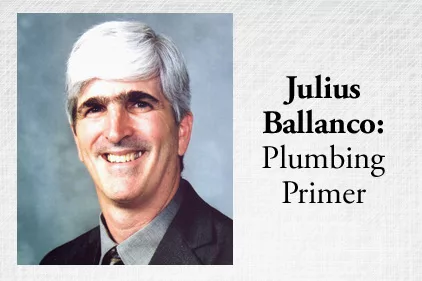Mysteries of wet venting in bathrooms
It doesn’t help that the Uniform Plumbing Code only recently added traditional wet venting to the code, although the name was changed to horizontal wet venting.

My cousin gave me a copy of a local plumbing code in New Jersey dating back to the 1920s. The small pamphlet is only 37 pages long. However, when you read the venting section, you find the precursor of wet venting. That wasn’t what it was called, but the installation requirement is what we call wet venting today.
What is interesting is that wet venting has existed almost since the beginning of plumbing regulations in this country. Amazingly, we still struggle to understand it. As I travel across this great country of ours, I am constantly asked about wet venting — what are its limitations, how do you install it and what pipe sizes are acceptable?
It is hard to believe the first wet venting installation I installed dated back more than 45 years. I still know where the house is on Kinderkamack Rd. in Montvale, N.J. I think the system is still working.
Since that time, not much has changed in wet venting but there has been a lot of confusion. It doesn’t help that the Uniform Plumbing Code only recently added traditional wet venting to the code, although the name was changed to horizontal wet venting. Unfortunately, in the newer edition of the UPC, arbitrary restrictions were added, which can be traced to a lack of understanding of wet venting.
So what is wet venting? Traditional wet venting is the venting of one or two bathroom groups. A bathroom group includes all the fixtures located within a bathroom, such as a water closet, lavatory, bathtub, shower or bidet. All these fixtures can be vented with a single dry vent. Notice how it is identified as a dry vent. Technically, every fixture has a vent; however, the vent is wet, hence the term wet vent.
The wet vent can serve as the drain for another fixture. This is important to keep in mind when determining the distance from trap to vent. That distance is measured from the fixture trap to the wet-vent connection. The distance is not measured all the way back to the dry vent. However, if it is the first fixture in the venting system, it is measured to the dry-vent connection.
The other simple fact to remember is the horizontal fixtures connect horizontally to the drain and the vertical fixtures connect vertically or horizontally to the horizontal drain. What that means is the horizontal fixtures are not rolled into the main horizontal drain. If you roll the pipe into the main drain, you have a vertical connection and you just screwed up the wet-vent system. The venting principle is based on horizontal flow in the main piping. The only vertical connections would be from the lavatory or bidet. All the other fixtures are floor-mounted fixtures, connecting horizontally to the main drain.
Simple sizing rules
Sizing is rather simple. One fixture unit is allowed to discharge to a 1 1/2–in. drain, such as a lavatory or bidet. A 2–in. pipe can receive up to four fixture units. After that, the wet vent must be 3 in. You can have a total of two bathroom groups, so the wet vent never has to be larger than 3 in.
The dry-vent extension of the wet-vented system only has to be 1 1/2 in. Or you could terminate the wet vent to an air admittance valve rated for 1 1/2 in. and the fixture unit value of the entire wet-vented system. Some smaller air admittance valves cannot serve a wet-vented bathroom group.
As simple as the wet-venting system is, plumbing codes often add unnecessary requirements. The most commonly added requirement is that the water closet must be the last fixture in the wet-vented system. That makes it difficult for a double bathroom group wet vent. The two water closets would have to tie in together.
Actually, there is no technical justification for making the water closet the last fixture. Thousands of wet-vented systems are working where the water closet is not the last fixture. Someone assumed the water closet is a blow-out fixture that blasts through the pipe, sucking everything with it. Well, that isn’t true.
Another common amendment is the size of the piping. Quite often, the 1 1/2-in. size is deleted. Some in the profession believe a water closet needs a 2-in. vent. Thus, they make the smallest pipe in the wet-vented system at 2 in. Again, this is unnecessary and not technically supported. You could vent a water closet with a straw. The air movement is based on the length of the pipe and the friction loss in the piping. Hence, a straw is very short with little friction; an adequate amount of air would enter the piping.
The amount of air you need to vent a bathroom group is less than 1 cubic ft. per min. You typically use 1 cfm to blow out a candle on your birthday cake. That puts it into perspective as to how little air is required to vent an entire bathroom.
The other changes that occur are the elimination of a second bathroom group, the addition of other fixtures and the modification of the piping arrangement into all vertical piping. Again, all these modifications are unnecessary.
If you ever run into problems with wet venting, realize that it only takes a little education to understand the system. Don’t be afraid to explain the workings of a wet vent.
Whenever possible, I wet vent a bathroom group. It is one of the easiest and least expensive ways to vent all the fixtures. Plus, it works!
Looking for a reprint of this article?
From high-res PDFs to custom plaques, order your copy today!








